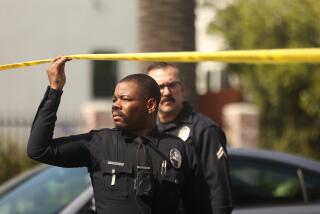Sacramento Found Most Dangerous County for Walking
- Share via
Sacramento County is the most dangerous place for pedestrians in California, but Los Angeles County still has the highest numbers of deaths and injuries of those on foot, according to a new study released Thursday.
After adjustments were made for population and numbers of pedestrians, Sacramento County, with 1.2 million residents, and Contra Costa, County with 932,000 residents, were ranked on top, over Los Angeles.
In Sacramento, 30 pedestrians were killed in 1999 and 516 were injured, according to researchers at the Surface Transportation Policy Project. In smaller Contra Costa, eight were killed and 302 injured.
In Los Angeles County, with a population of 9.7 million, 203 pedestrians were killed in 1999 and 5,377 were injured. Also high on the list were Santa Clara and San Mateo counties.
Gloria Ohland, a co-author of the study, said Sacramento and Contra Costa counties, which rated fourth and fifth in a previous study, rose to the top because of an increase in fatalities and injuries apparently spurred by new growth.
“The new growth is usually suburban style, and they are anti-pedestrian in design,” she said. “Sometimes there are no sidewalks and traffic is moving so fast, [pedestrians] don’t even have a chance.”
Sacramento County officials express dismay at the rating Thursday, noting that the county is working on a pedestrian master plan.
Researchers chose the treacherous intersection of Mott Street and Wabash Avenue in Boyle Heights to release the study.
“Most of these vehicles are traveling well above the speed limit,” said parking meter officer Abel Cervantes. “And see that stop sign hiding behind that tree across the street? Not a good deal. See those kids running across the street? They’re running for their lives.”
‘Forget about turning right or left off Mott onto Wabash,” he added. “On the right, you’re blinded by trees, on the left by a steel tower.”
You didn’t have to be a traffic cop to understand the risks. Anastacio Parral, 33, who lives in a small house overlooking the intersection said, “We get about six to eight accidents, or near misses, a month.”
“Seems every few days we hear squealing brakes, then ‘Pow!’ ” he said. “My kids do not cross unless they are with me or my wife.”
Across California, 688 pedestrians were killed in 1999, accounting for nearly 20% of all traffic-related fatalities, according to the study.
Statewide, young African Americans and Latinos are much more likely to become victims of a pedestrian-vehicle collision. Pedestrians hospitalized in 1999 for their injuries were also found to be more likely to be low-income.
“We can’t forget that behind all these statistics about pedestrian deaths and injuries are real people: Latinos, African Americans, and the working poor, many of whom depend on walking not by choice but by necessity,” said James Rojas of Latino Urban Forum.
The study says that wider boulevards, more turn lanes, fewer crosswalks and more cars traveling faster are to blame for the high level of fatalities and injuries.
Orange County jumped from eight to six on the list of most dangerous pedestrian zones because its pedestrian fatalities increased from 36 to 45 in 1999.
Ventura County also was ranked in the top 10 counties for the first time, with pedestrians suffering 13 fatalities and 243 injuries.
Overall, the number of pedestrian deaths statewide is slightly down statewide, a reflection of a national trend. But the study co-author James Corless attributes that to a decrease in the number of people walking. “Pedestrians are an endangered species,” said Corless, the project’s California director.
According to the study, Caltrans spends less than 1% of its federal traffic safety funds on pedestrians, the lowest percentage of any state.
Caltrans officials say the study is flawed. “Such studies fail to recognize that many of our projects have pedestrian and safety components built into them,” said Dennis Tujillo, a Caltrans spokesman.
*
Times staff writer Louis Sahagan and Community News correspondent Catherine Blake contributed to this story.
More to Read
Sign up for Essential California
The most important California stories and recommendations in your inbox every morning.
You may occasionally receive promotional content from the Los Angeles Times.














